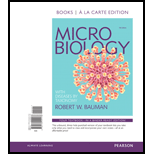
Concept explainers
To fill: The concept map that describes bacterial meningitis.
Introduction:
The Gram negative diplococcus pathogen N. meningitidis causes a fatal disease called meningitis in mostly children. Upon infection, the bacteria invade the lower respiratory system of an individual, making the bacteria spread from the infected individual to the other healthy individual through exhaled droplets. The symptoms for meningitis includes headache, as reported by the boy, followed by death within 6 hours of the appearance of symptoms.
Fatal meningitis can also be caused by the Gram negative bacillus Haemophilus influenzae in children between 18 months to 3 years of age. It can be diagnosed by observing excessive crying, stiff neck, and fever
Want to see the full answer?
Check out a sample textbook solution
Chapter 20 Solutions
LOOSE LEAF TEXT W/ MODIFIED MAST MICRO
- Please select all of the statements that apply to chlamydial infections. (NOTE: Please change all question marks to checkmarks for correct answers or empty boxes for incorrect answers.) Check All That Apply Caused by Chlamydia trachomatis, a rod-shaped bacterium. Caused by Chlamydia trachomatis, a rod-shaped bacterium. Causative agent is an obligate intracellular parasite. Causative agent is an obligate intracellular parasite. Causative agent has two forms: elementary body and reticulate body. Causative agent has two forms: elementary body and reticulate body. Causative agent has two stages: cercaria and miracidium. Causative agent has two stages: cercaria and miracidium. Newborn babies of infected mothers can develop chlamydial eye infections.arrow_forwardSleeping sickness (African trypanosomiasis) Mode of Transmission: Hallmark of Infection: Drug of Choice: American trypanosomiasis (Chagas disease) Mode of Transmission: Hallmark of Infection: Drug of Choice:arrow_forwardComplete the following table: DISEASE CAUSATIVE ORGANISM VECTOR Leishmaniasis sand fly - phlebotomus Plague Rocky Mountain Spotted Fever West Nile Virus Hantavirus Pulmonary Syndrome Dengue Tularemia Rabiesarrow_forward
- For the following diseases: list the most likely culprits (or pathogen) responsible for causing it. Include treatment alternatives (PCN allergies) and drug classification: H. Pylori/ Peptic Ulcer Disease. Otitis Media. Community Acquired Pneumonia. Clostridium Difficile. Sinusitisarrow_forwardIdentify the agents (bacterial) of these bacterial infections. Include the signs and symptoms; overview of the pathogen and its virulence factors; pathogenesis and epidemiology; diagnosis, treatment and prevention. A. Bacterial Infections of the Circulatory System 1. Rickettsia spp. 2. Yersinia pestis 3. Francisella tularensis 4. Ehrlichia chaffeensis & Ehrilchia eguiarrow_forwardIdentify the MISMATCH from the following pairs Group of answer choices chicken pox :::: aerosole transmitted Nesisseria gonorrhoeae ::::: uses cork screw motion to enter enveloped viruses :::: direct person to person transmission common cold virus ::::: conjunctiva entry Hepatitis C entry :::: parenteral route of entryarrow_forward
- Table of Staphylococcus aureus and it should contain the following details. Clinical infections/ Diseases Virulence Factors and their mechanism of action. Microscopic morphology Cultural morphology Laboratory Diagnosisarrow_forwardWhat is the correct signs and symptoms of the stages of infection in terms of: Incubation Prodromal Illness Convalescence The choices are written in the box, which is provided. Thank you experts!arrow_forwardPin-point hemorrhage refers to which of the following? Ecchymosis Petechia Hematoma Puncture woundarrow_forward
 Comprehensive Medical Assisting: Administrative a...NursingISBN:9781305964792Author:Wilburta Q. Lindh, Carol D. Tamparo, Barbara M. Dahl, Julie Morris, Cindy CorreaPublisher:Cengage LearningEssentials of Pharmacology for Health ProfessionsNursingISBN:9781305441620Author:WOODROWPublisher:Cengage
Comprehensive Medical Assisting: Administrative a...NursingISBN:9781305964792Author:Wilburta Q. Lindh, Carol D. Tamparo, Barbara M. Dahl, Julie Morris, Cindy CorreaPublisher:Cengage LearningEssentials of Pharmacology for Health ProfessionsNursingISBN:9781305441620Author:WOODROWPublisher:Cengage Microbiology for Surgical Technologists (MindTap ...BiologyISBN:9781111306663Author:Margaret Rodriguez, Paul PricePublisher:Cengage Learning
Microbiology for Surgical Technologists (MindTap ...BiologyISBN:9781111306663Author:Margaret Rodriguez, Paul PricePublisher:Cengage Learning Medical Terminology for Health Professions, Spira...Health & NutritionISBN:9781305634350Author:Ann Ehrlich, Carol L. Schroeder, Laura Ehrlich, Katrina A. SchroederPublisher:Cengage Learning
Medical Terminology for Health Professions, Spira...Health & NutritionISBN:9781305634350Author:Ann Ehrlich, Carol L. Schroeder, Laura Ehrlich, Katrina A. SchroederPublisher:Cengage Learning





